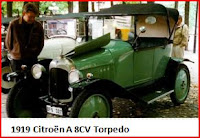Citroen first breed was made in 1919 and stop its era in 1933. During this era, manual steering system are used as the car control system. this type of steering have no additional support system(such as hydraulic, pnuematic or EPS ) which means the power transmit from the steering to the tyre are via gear itselfType
Manual steering system have many type. some of it are widely used and the others are used in certain occasion. there are 5 types of manual steering system:
- Rack & Pinion
- Recirculating Ball Steering
- Worm and Sector Steering
- Worm and Tapered Peg Steering
- Worm and Roller Steering
Example
This are the example of citroen first modal produced in 1919 - 1933
1934 – 1951
In this era, citroen has successfully develop a car using power steering which function with the use of high-pressure hydraulic system. This system were used in the DS modal and still use in today modal as it’s basis such as the SM, GS, CX, BX, XM, Xantia, C5 and C6.
The power steering system consist of 2 possible types:
1) DIRASS from the French Direction Asistée
2) DIRAVI (Direction Appel Rasservi) or, Varipower
DIRASS
It is the conventional power steering where normally used in most car, where most power steering systems work by using a hydraulic system to steer the vehicle's wheels. The hydraulic pressure typically comes from a gerotor or rotary vane pump driven by the vehicle's engine. A double-acting hydraulic cylinder applies a force to the steering gear, which in turn steers the roadwheels. The steering wheel operates valves to control flow to the cylinder, the valve allows fluid to flow to the cylinder which provides steering assistance. The more torque the driver applies to the steering wheel and column, the more fluid the valves allow through to the cylinder, and so the more force is applied to steer the wheels
DIRAVI (Power Steering With Power Assisted Return)
This type is a self-centering, speed sensitive, fully amplified system that were design and develop by citroen itself. This system is completely different from the conventional one.The force steer the wheels comes from the car's high pressure hydraulic system and is always the same no matter what the road speed is. Its peculiarity is that it automatically centers the steering even if the car is standing still, and is less servo assisted at higher speeds and tighter curves.
ADVANTAGES
|
DISADVANTAGES
|
ü Requires minimal physical exertion
|
ü No feedback to the driver because it’s entirely artificial and bears no relation to the actual forces on the front wheels from the vehicle's inertia and the roadway
|
ü Devotees find DIRAVI a delight to use. Exasperating to those not willing to accustom themselves, especially on the SM.
|
ü Driver must survey visual cues to determine approach of roadholding limit
|
ü Fast operation during turning
|
ü Requires familiarization and difficult for novice user to control because it is too fast and sensitive
|
ü Can be set up permitting vehicle to travel in a straight line without driver input on a constant camber road in still conditions
| |
ü Blowouts, chuckholes, ruts, etc. cannot affect the steering wheel or the direction of the steered wheels which can only be moved by steering wheel input
|
In the DS modal, DIRASS power steering system is used as well as in the other modal with the same age for citroen conventional car type.
For the DIRAVI type, it is used when Citroën purchased the Italian sports car maker Maserati and launched the grand tourer SM, which featured a V6 Maserati engine and a fully powered steering system.
Electro-hydraulic power steering systems, sometimes abbreviated EHPS, and also sometimes called "hybrid" systems, use the same hydraulic assist technology as standard systems, but the hydraulic pressure comes from a pump driven by an electric motor instead of a drive belt at the engine. it is acombination of EPS and hydraulic steering system that decrease the ratio between
steering wheel and movement of tyre up to 15:1.
this system also avoid running hydraulic lines from the engine up to the steering rack
Steer by Wire
The aim of steer by wire technology is to completely do away with as many mechanical components (steering shaft, column, gear reduction mechanism, etc.) as possible. Completely replacing conventional steering system with steer - by-wire holds several advantages, such as:
Ø The absence of steering column simplifies the car interior design.
Ø The absence of steering shaft, column and gear reduction mechanism allows
much better space utilization in the engine compartment.
Ø The steering mechanism can be d esigned and installed as a modular unit.
Ø Without mechanical connection between the steering wheel and the road
wheel, it is less likely that the impact of a frontal crash will force the steering
wheel to intrude into the driver's survival space.
Ø Steering system characteristics can easily and infinitely be adjusted to
optimize the steering response and feel.
In citroen, the steer by wire technology has been use in the "C5 by wire" where no pedal is use. the acceleration and braking system is control at the steering wheel. By eliminating mechanical limits and constraints, it aims to pioneer more attractive and ergonomic cockpit design that adapts to the needs of each driver and brings significant progress in active safety











